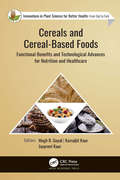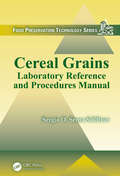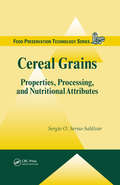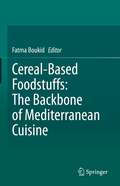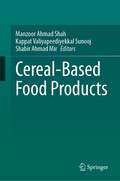- Table View
- List View
Cerebral Autoregulation: Control of Blood Flow in the Brain (SpringerBriefs in Bioengineering)
by Stephen PayneThis Brief provides a comprehensive introduction to the control of blood flow in the brain. Beginning with the basic physiology of autoregulation, the author goes on to discuss measurement techniques, mathematical models, methods of analysis, and relevant clinical conditions, all within this single volume. The author draws together this disparate field, and lays the groundwork for future research directions. The text gives an up-to-date review of the state of the art in cerebral autoregulation, which is particularly relevant as cerebral autoregulation moves from the laboratory to the bedside. Cerebral Autoregulation will be useful to researchers in the physical sciences such as mathematical biology, medical physics, and biomedical engineering whose work is concerned with the brain. Researchers in the medical sciences and clinicians dealing with the brain and blood flow, as well as industry professionals developing techniques such as ultrasound, MRI, and CT will also find this Brief of interest.
Cereals in Breadmaking: A Molecular Colloidal Approach
by Ann-Charlotte Eliasson Larsson KareThis reference text describes the breadmaking process at the molecular level, based on surface and colloidal science and introducing colloidal science with a minimum of theory.;Reviewing the current molecular and colloidal knowledge of the chain from wheat grain to bread, the book: discusses the structure of the dough, how a foam is formed during fermentation and how starch gelatinization induces the formation of an open-pore network, such as the bread crumb; covers new results on the gluten structure in bulk and at interfaces, as well as on phase separation in the dough; presents a complete model of all structural transitions from dough mixing to the formation of a bread; details the physicochemical properties of proteins, lipids and carbohydrates in wheat and other cereals, and considers their modes of interaction; and explores recent progress in the shape of biomolecular assemblies, derived from forces and curvature at interfaces.;The text provides nearly 850 citations from the reference literature.
Cereals in Breadmaking: A Molecular Colloidal Approach
by Ann-Charlotte Eliasson Larsson KareThis reference text describes the breadmaking process at the molecular level, based on surface and colloidal science and introducing colloidal science with a minimum of theory.;Reviewing the current molecular and colloidal knowledge of the chain from wheat grain to bread, the book: discusses the structure of the dough, how a foam is formed during fermentation and how starch gelatinization induces the formation of an open-pore network, such as the bread crumb; covers new results on the gluten structure in bulk and at interfaces, as well as on phase separation in the dough; presents a complete model of all structural transitions from dough mixing to the formation of a bread; details the physicochemical properties of proteins, lipids and carbohydrates in wheat and other cereals, and considers their modes of interaction; and explores recent progress in the shape of biomolecular assemblies, derived from forces and curvature at interfaces.;The text provides nearly 850 citations from the reference literature.
Cereals and Pulses: Nutraceutical Properties and Health Benefits (Hui: Food Science and Technology)
by Liangli L. Yu Rong Tsao Fereidoon ShahidiCereal and pulse crops are staple foods that provide essential nutrients to many populations of the world. Traditionally, whole grains were consumed but most current foods are derived from refined fractions of cereal and pulse crops. Consumption of processed or refined products may reduce the health benefits of food. In wheat-based processed foods, for example, the removed 40% of the grain (mainly the bran and the germ of the wheat grain) contains the majority of the health beneficial components. These components, particularly non-essential phytochemicals such as carotenoids, polyphenols, phytosterols/ stanols, and dietary fibers, have been shown to reduce the risk of major chronic diseases of humans, such as cancer, cardiovascular diseases, and Parkinson’s disease. Such bioactives are therefore good candidates for ingredients of nutraceuticals and functional foods. There are many factors that can affect the bioactive content of cereal and pulse-based food ingredients, including genetics, growing and storage conditions, post-harvest treatments, food formulation and processing. All of these factors ultimately affect human health and wellness. Bioavailability is also important for these compounds for exerting their protective roles. Cereals and Pulses: Nutraceutical Properties and Health Benefits provides a summary of current research findings related to phytochemical composition and properties of cereal and pulse crops. The nutraceutical properties of each major cereal and pulse are discussed. Coverage of cereals and pulse crops includes barley, oats, rice, rye, corn, adlay, wheat, buckwheat, psyllium, sorghum, millet, common beans, field peas, faba beans, chickpea, lentil and soybeans. Chapters for each crop discuss methods to improve crop utilization, nutraceutical components and properties, bioactive compositions, antioxidant properties, beneficial health effects, disease prevention activities, and areas for future research. Also included are two chapters that examine the beneficial health properties of dietary fibers and antioxidants. Edited and written by an international team of respected researchers, this book is a reference guide for scientists working in food ingredients, food product research and development, functional foods and nutraceuticals, crop breeding and genetics, human nutrition, post-harvest treatment and processing of cereal grains and pulses. It will enable them to effect value-added food innovation for health promotion and disease risk reduction.
Cereals and Pulses: Nutraceutical Properties and Health Benefits (Hui: Food Science and Technology)
by Liangli Lucy Yu Rong Tsao Fereidoon ShahidiCereal and pulse crops are staple foods that provide essential nutrients to many populations of the world. Traditionally, whole grains were consumed but most current foods are derived from refined fractions of cereal and pulse crops. Consumption of processed or refined products may reduce the health benefits of food. In wheat-based processed foods, for example, the removed 40% of the grain (mainly the bran and the germ of the wheat grain) contains the majority of the health beneficial components. These components, particularly non-essential phytochemicals such as carotenoids, polyphenols, phytosterols/ stanols, and dietary fibers, have been shown to reduce the risk of major chronic diseases of humans, such as cancer, cardiovascular diseases, and Parkinson’s disease. Such bioactives are therefore good candidates for ingredients of nutraceuticals and functional foods. There are many factors that can affect the bioactive content of cereal and pulse-based food ingredients, including genetics, growing and storage conditions, post-harvest treatments, food formulation and processing. All of these factors ultimately affect human health and wellness. Bioavailability is also important for these compounds for exerting their protective roles. Cereals and Pulses: Nutraceutical Properties and Health Benefits provides a summary of current research findings related to phytochemical composition and properties of cereal and pulse crops. The nutraceutical properties of each major cereal and pulse are discussed. Coverage of cereals and pulse crops includes barley, oats, rice, rye, corn, adlay, wheat, buckwheat, psyllium, sorghum, millet, common beans, field peas, faba beans, chickpea, lentil and soybeans. Chapters for each crop discuss methods to improve crop utilization, nutraceutical components and properties, bioactive compositions, antioxidant properties, beneficial health effects, disease prevention activities, and areas for future research. Also included are two chapters that examine the beneficial health properties of dietary fibers and antioxidants. Edited and written by an international team of respected researchers, this book is a reference guide for scientists working in food ingredients, food product research and development, functional foods and nutraceuticals, crop breeding and genetics, human nutrition, post-harvest treatment and processing of cereal grains and pulses. It will enable them to effect value-added food innovation for health promotion and disease risk reduction.
Cereals and Millets (Genome Mapping and Molecular Breeding in Plants #1)
by Chittaranjan KolePart of the seven-volume series Genome Mapping and Molecular Breeding in Plants, this book covers Cereals and Millets, which provide staple food for most of the earth’s population. This book includes chapters on rice, wheat, maize, barley, oats, rye, sorghum, pearl millet, foxtail millet and finger millet. The emphasis is on advanced research on the major crops, including the model plants maize and rice, as well as on future road maps of genomic research for the less-often considered but equally deserving cereals and millets.
Cereals and Cereal-Based Foods: Functional Benefits and Technological Advances for Nutrition and Healthcare
by Megh R. Goyal Kamaljit Kaur Jaspreet KaurThis book volume sheds light on the health benefits of selected cereal grains, processing technologies of cereals, specific roles of bioactive compounds of cereals in chronic disease prevention, and traditional and latest technologies to improve the functional benefits of cereal-based products. It presents a thorough review of the functional components of some lesser known or forgotten cereals and their role in maintaining good health. With advancements in cereal science and technology, new methods of processing have emerged that help to preserve or even enhance the health-benefitting properties of cereal grains. Further, plant breeding and biotechnology have contributed greatly in improving nutritional quality and functionality of these grains. This book provides comprehensive information on the simple as well as advanced methodologies for enhancing the properties of cereals that benefit human health. Some new approaches such as bio-fortification and extraction of bioactives from cereals are also included in the text.
Cereals (Handbook of Plant Breeding #3)
by Marcelo J. CarenaAgriculture depends on improved cultivars, and cultivars are developed through proper plant breeding. Unfortunately, applied plant breeding programs that are focused on cereal commodity crops are under serious erosion because of lack of funding. This loss of public support affects breeding continuity, objectivity, and, perhaps equally important, the training of future plant breeders and the utilization and improvement of plant genetic resources currently available. Breeding programs should focus not only on short-term research goals but also on long-term genetic improvement of germplasm. The research products of breeding programs are important not only for food security but also for commodity-oriented public and private programs, especially in the fringes of crop production. Breeding strategies used for long-term selection are often neglected but the reality is that long-term research is needed for the success of short-term products. An excellent example is that genetically broad-based public germplasm has significantly been utilized and recycled by industry, producing billions of dollars for industry and farmers before intellectual property rights were available. Successful examples of breeding continuity have served the sustainable cereal crop production that we currently have. The fact that farmers rely on public and private breeding institutions for solving long-term challenges should influence policy makers to reverse this trend of reduced funding. Joint cooperation between industry and public institutions would be a good example to follow. The objective of this volume is to increase the utilization of useful genetic resources and increase awareness of the relative value and impact of plant breeding and biotechnology. That should lead to a more sustainable crop production and ultimately food security. Applied plant breeding will continue to be the foundation to which molecular markers are applied. Focusing useful molecular techniques on the right traits will build a strong linkage between genomics and plant breeding and lead to new and better cultivars. Therefore, more than ever there is a need for better communication and cooperation among scientists in the plant breeding and biotechnology areas. We have an opportunity to greatly enhance agricultural production by applying the results of this research to meet the growing demands for food security and environmental conservation. Ensuring strong applied plant breeding programs with successful application of molecular markers will be essential in ensuring such sustainable use of plant genetic resources.
Cereal Processing Technologies: Impact on Nutritional, Functional, and Biological Properties
by Rajan Sharma B. N. Dar Savita SharmaCereals are the principal dietary components of human diet and have been for several thousand years. Whole grain cereals are not only an excellent source of energy, but also enrich the diet. The processing of cereals prior to consumption is a necessary step in production chain to make them palatable and enhance bio- and techno-functional performance. Cereal Processing Technologies: Impact on Nutritional, Functional, and Biological Properties reviews cereal processing technologies and their impact on quality attributes of cereals, detailing the processing techniques of cereals with recent advancements followed by their impact on nutritive, functional and biological potential. Each chapter covers three major components as a) technological details for the processing treatment, b) impact on nutritive, functional and biological properties and c) characterization of processed products. Key Features: Focuses on different cereals for nutritive and functional characteristics Explores mechanical, biological, thermal and non-thermal processing treatments of cereals Presents impact of different treatments on biological and techno-functional properties of cereals Discusses characteristics of the processed products The contents of Cereal Processing Technologies are an asset for researchers, students and professionals, and can be potentially used as a reference and important resource for academia and future investigations. This book helps readers identify how different techniques for processing cereal grains enhance the targeted nutritional and functional quality.
Cereal Processing Technologies: Impact on Nutritional, Functional, and Biological Properties
by Rajan Sharma Basharat Nabi Dar Savita SharmaCereals are the principal dietary components of human diet and have been for several thousand years. Whole grain cereals are not only an excellent source of energy, but also enrich the diet. The processing of cereals prior to consumption is a necessary step in production chain to make them palatable and enhance bio- and techno-functional performance. Cereal Processing Technologies: Impact on Nutritional, Functional, and Biological Properties reviews cereal processing technologies and their impact on quality attributes of cereals, detailing the processing techniques of cereals with recent advancements followed by their impact on nutritive, functional and biological potential. Each chapter covers three major components as a) technological details for the processing treatment, b) impact on nutritive, functional and biological properties and c) characterization of processed products. Key Features: Focuses on different cereals for nutritive and functional characteristics Explores mechanical, biological, thermal and non-thermal processing treatments of cereals Presents impact of different treatments on biological and techno-functional properties of cereals Discusses characteristics of the processed products The contents of Cereal Processing Technologies are an asset for researchers, students and professionals, and can be potentially used as a reference and important resource for academia and future investigations. This book helps readers identify how different techniques for processing cereal grains enhance the targeted nutritional and functional quality.
Cereal Grains: Composition, Nutritional Attributes, and Potential Applications
by Gulzar Ahmad Nayik Tabussam Tufail Faqir Muhammad Anjum Mohammad Javed AnsariEver since the beginnings of agriculture, cereals have provided unlimited health benefits to mankind as a staple food in our diet. Cereals are rich in complex carbohydrates that provide us ample energy, and help to prevent many diseases such as constipation, colon disorders, and high blood sugar levels. They enrich our overall health with abundant proteins, fats, lipids, minerals, vitamins, and enzymes. In every part of the world cereals are consumed for breakfast, lunch or dinner. Cereal Grains: Composition, Nutritional Attributes, and Potential Applications provides an overview of cereals including their properties, chemical composition, applications, postharvest losses, storage, and quality. Various well-versed researchers across the globe share their knowledge and experience covering cereal’s role in food security, allergens in grains, phytochemical profile, industrial applications, health benefits, global standard of cereals, and recent advances in cereal processing. Key Features: Contains comprehensive information on general composition and properties of cereals. Discusses the recent advances in cereal technology Provides knowledge on bioactive characterization of cereal grains Contain information on future aspect of grain quality and allergens in cereal grains This handbook is a valuable resource for students, researchers, and industrial practitioners who wish to enhance their knowledge and insights on cereal science. Researchers, scientists, and other professionals working in various cereal processing industries and other horticultural departments will also find the comprehensive information relevant to their work.
Cereal Grains: Composition, Nutritional Attributes, and Potential Applications
by Gulzar Ahmad Nayik Tabussam Tufail Faqir Muhammad Anjum Mohammad Javed AnsariEver since the beginnings of agriculture, cereals have provided unlimited health benefits to mankind as a staple food in our diet. Cereals are rich in complex carbohydrates that provide us ample energy, and help to prevent many diseases such as constipation, colon disorders, and high blood sugar levels. They enrich our overall health with abundant proteins, fats, lipids, minerals, vitamins, and enzymes. In every part of the world cereals are consumed for breakfast, lunch or dinner. Cereal Grains: Composition, Nutritional Attributes, and Potential Applications provides an overview of cereals including their properties, chemical composition, applications, postharvest losses, storage, and quality. Various well-versed researchers across the globe share their knowledge and experience covering cereal’s role in food security, allergens in grains, phytochemical profile, industrial applications, health benefits, global standard of cereals, and recent advances in cereal processing. Key Features: Contains comprehensive information on general composition and properties of cereals. Discusses the recent advances in cereal technology Provides knowledge on bioactive characterization of cereal grains Contain information on future aspect of grain quality and allergens in cereal grains This handbook is a valuable resource for students, researchers, and industrial practitioners who wish to enhance their knowledge and insights on cereal science. Researchers, scientists, and other professionals working in various cereal processing industries and other horticultural departments will also find the comprehensive information relevant to their work.
Cereal Grains: Laboratory Reference and Procedures Manual (Food Preservation Technology Ser.)
by Sergio O. Serna-SaldivarEmphasizing the essential principles underlying the preparation of cereal-based products and demonstrating the roles of ingredients, Cereal Grains: Laboratory Reference and Procedures Manual is a practical laboratory manual complementing the author's text, Cereal Grains: Properties, Processing, and Nutritional Attributes. Organized so that readers
Cereal Grains: Laboratory Reference and Procedures Manual (Food Preservation Technology Ser.)
by Sergio O. Serna-SaldivarEmphasizing the essential principles underlying the preparation of cereal-based products and demonstrating the roles of ingredients, Cereal Grains: Laboratory Reference and Procedures Manual is a practical laboratory manual complementing the author's text, Cereal Grains: Properties, Processing, and Nutritional Attributes. Organized so that readers
Cereal Grains: Properties, Processing, and Nutritional Attributes (Food Preservation Technology Ser.)
by Sergio O. Serna-SaldivarWhile cereals remain the world's largest food yield - with more than 2.3 billion metric tons produced annually - consumer demands are on the rise for healthier cereal products with greater nutrition. Cereal Grains: Properties, Processing, and Nutritional Attributes provides a complete exploration of the scientific principles related to domesticatio
Cereal Grains: Properties, Processing, and Nutritional Attributes
by Sergio O. Serna-SaldivarWhile cereals remain the world's largest food yield - with more than 2.3 billion metric tons produced annually - consumer demands are on the rise for healthier cereal products with greater nutrition. Cereal Grains: Properties, Processing, and Nutritional Attributes provides a complete exploration of the scientific principles related to domesticatio
Cereal Grain Quality
by R. Henry P. KettlewellCereal uses range from human food and beverages to animal feeds and industrial products. It is human food and beverages which are the predominant uses covered in this book, since the nutritional quality of cereals for animal feed is described in other publications on animal nutrition, and industrial products are a relatively minor use of cereals. Cereals are the main components of human diets and are crucial to human survival. Three species, wheat, rice and maize, account for the bulk of human food. Barley is the major raw material for beer production and ranks fourth in world production. Other species such as sorghum are regionally important. This book covers all the major cereal species: wheat, rice, maize, barley, sorghum, millet, oats, rye and triticale. Specific chapters have been devoted to a description of the major end-uses of each of the species and to definition of the qualities required for each of their end uses. The functional and nutritional quality of cereals determines their suitability for specific purposes and may limit the quality of the end product, influencing greatly the commercial value of grain. An under standing of the factors that determine grain quality is thus important in the maintenance of efficient and sustainable agricultural and food production. The biochemical constituents of the grain that determine quality have been described in chapters on proteins, carbohydrates and other components. An understanding of the relationships between grain composition and quality is important in selecting grain for specific uses.
Cereal Genomics II
by Pushpendra K. Gupta and Rajeev K. Varshney“Cereal Genomics” published in 2004 served the purpose of collecting all information on cereal genomics at one place and was well received by the cereal workers through-out the world. The last eight years have witnessed significant advancement in the field of cereal genomics. For instance, high-density genetic maps, physical maps, QTL maps and even draft genome sequence have become available for several cereal species. Furthermore, the next generation sequencing (NGS) technologies have revolutionized genomics research, so that it is possible now to sequence genomes of hundreds or thousands of accessions of an individual cereal crop. Significant amounts of data generated using these NGS technologies created a demand for computational tools to analyse this massive data. In view of these developments, the Editors realised that there was a need to have an updated volume on the present status and future prospects of cereal genomics. These developments related to technology and the tools have been documented in this volume, thus supplementing our earlier edited volume “Cereal Genomics”. “Cereal Genomics II” discusses advances in cereal genomics research made during the last eight years, and presents state-of-art cereal genomics and its utilization involving both basic research such as comparative genomics and functional genomics, and applied research like QTL mapping and molecular breeding.
Cereal Genomics
by R. K. Varshney Pushpendra K. GuptaCereals make an important component of daily diet of a major section of human population, so that their survival mainly depends on the cereal grain production, which should match the burgeoning human population. Due to painstaking efforts of plant breeders and geneticists, at the global level, cereal production in the past witnessed a steady growth. However, the cereal production in the past has been achieved through the use of high yielding varieties, which have a heavy demand of inputs in the form of chemical fertilizers, herbicides and insecticides/pesticides, leading to environmental degradation. In view of this, while increasing cereal production, one also needs to keep in mind that agronomic practices used for realizing high productivity do not adversely affect the environment. Improvement in cereal production in the past was also achieved through the use of alien genetic variation available in the wild relatives of these cereals, so that conservation and sustainable use of genetic resources is another important area, which is currently receiving the attention of plant breeders. The work leading to increased cereal production in the past received strong support from basic research on understanding the cereal genomes, which need to be manipulated to yield more from low inputs without any adverse effects as above. Through these basic studies, it also became fairly apparent that the genomes of all cereals are related and were derived from the same lineage, million of years ago.
Cereal Crops: Genetic Resources and Breeding Techniques
by Tariq Shah Lixiao Nie Marcelo Teixeira Filho Rabia AmirCereal Crops: Genetic Resources and Breeding Techniques provides the reader practical tools for understanding relationships and challenges of successful farming; improvements to genetic modifications; and environmentally sound methods of production of bulk and quality cereals including wheat, maize, rice, barley, and millets. It explores the trait mapping, cropping systems, genome engineering, and identification of specific germplasms needed for the more effective development of biotic and abiotic stress resistant cereals within the framework of ensuring future food supplies around the world. Features:Focuses on cropping systems, genetics and genome engineering for higher crop production at a global level.Features information on specific prebiotic formulas to ward off adverse effects of antibiotics.Covers mechanistic as well as practical approaches for enhancing crop production in a sustainable way.Includes further in-depth analysis of various topics following each chapter.This is a vital resource for researchers, crop biologists, and students working with crop production and climate changes that have a significant impact on crop production, spanning basic to advanced level discussions of plant breeding, molecular genetics, and agronomy. Covering mechanistic and practical approaches for enhancing crop production in a sustainable way, this text is beneficial to intensive farmers and stakeholders in the field of crop production.
Cereal Crops: Genetic Resources and Breeding Techniques
by Tariq Shah, Lixiao Nie, Marcelo Carvalho Minhoto Texeira Filho, and Rabia AmirCereal Crops: Genetic Resources and Breeding Techniques provides the reader practical tools for understanding relationships and challenges of successful farming; improvements to genetic modifications; and environmentally sound methods of production of bulk and quality cereals including wheat, maize, rice, barley, and millets. It explores the trait mapping, cropping systems, genome engineering, and identification of specific germplasms needed for the more effective development of biotic and abiotic stress resistant cereals within the framework of ensuring future food supplies around the world. Features:Focuses on cropping systems, genetics and genome engineering for higher crop production at a global level.Features information on specific prebiotic formulas to ward off adverse effects of antibiotics.Covers mechanistic as well as practical approaches for enhancing crop production in a sustainable way.Includes further in-depth analysis of various topics following each chapter.This is a vital resource for researchers, crop biologists, and students working with crop production and climate changes that have a significant impact on crop production, spanning basic to advanced level discussions of plant breeding, molecular genetics, and agronomy. Covering mechanistic and practical approaches for enhancing crop production in a sustainable way, this text is beneficial to intensive farmers and stakeholders in the field of crop production.
Cereal-Based Foodstuffs: The Backbone of Mediterranean Cuisine
by Fatma BoukidCereal-Based Foodstuffs: The Backbone of the Mediterranean provides an overview of cereal-based products in the Mediterranean region, illustrating the spectrum of products from past to present and their various processing methods. The text explores new and understudied market trends in cereal-based products, such as cereal-pulse blends, pulse pastas, and flat breads. Chapters cover products originating in North Africa, such as bulgur and couscous, which are consumed worldwide but underrepresented in the scientific literature. Contributing authors also offer a legislative perspective on issues of food safety, the European Food Safety Association’s definition of “novel foods,” and the position of traditional foods in the Mediterranean food industry. This wide-ranging text thus serves members of both the scientific and industrial community seeking better coverage of global cereal product trends.
Cereal-Based Food Products
by Manzoor Ahmad Shah Kappat Valiyapeediyekkal Sunooj Shabir Ahmad MirCereal grains and their products are staples in the diet of almost every culture of the world and have made an important contribution to daily nutrient requirements. Cereal grains are high in carbohydrates, good sources of protein and provide varying amounts of fibre, vitamins and minerals. The nutritional composition of grains may vary depending on the variety and environmental growing conditions. A number of cereal products are prepared from all the regions of the world. Cereals are processed into many products such as bread, cookies, cakes and pasta and are consumed daily by the majority of the population and play an important place in human nutrition. Cereal Based Food Products is the first book of its kind, focusing on the preparation methodology of cereal products. The chapters focus on different types of cereal products, processing technology, quality aspects and packaging requirements. All of the important cereal-based foods are covered in full, including sections on bread, cookies, cakes and muffins, pasta and noodles and many more including their packaging, preparation methods and ingredients. With this text researchers will find a comprehensive single source for information on the processing of cereal-based food products.Covers different types of products prepared from cereal grains;Focuses on production technology for the development of cereal products;Presents information on packaging requirements of cereal products.
Ceramics Science and Technology, Volume 4: Applications (Ceramics Science and Technology (VCH))
by Ralf Riedel I-Wei ChenAlthough ceramics have been known to mankind literally for millennia, research has never ceased. Apart from the classic uses as a bulk material in pottery, construction, and decoration, the latter half of the twentieth century saw an explosive growth of application fields, such as electrical and thermal insulators, wear-resistant bearings, surface coatings, lightweight armour, and aerospace materials. In addition to plain, hard solids, modern ceramics come in many new guises such as fabrics, ultrathin films, microstructures and hybrid composites. Built on the solid foundations laid down by the 20-volume series Materials Science and Technology, Ceramics Science and Technology picks out this exciting material class and illuminates it from all sides. Materials scientists, engineers, chemists, biochemists, physicists and medical researchers alike will fi nd this work a treasure trove for a wide range of ceramics knowledge from theory and fundamentals to practical approaches and problem solutions.
Ceramics Science and Technology, Volume 4: Applications (Ceramics Science and Technology (VCH))
by Ralf Riedel I-Wei ChenAlthough ceramics have been known to mankind literally for millennia, research has never ceased. Apart from the classic uses as a bulk material in pottery, construction, and decoration, the latter half of the twentieth century saw an explosive growth of application fields, such as electrical and thermal insulators, wear-resistant bearings, surface coatings, lightweight armour, and aerospace materials. In addition to plain, hard solids, modern ceramics come in many new guises such as fabrics, ultrathin films, microstructures and hybrid composites. Built on the solid foundations laid down by the 20-volume series Materials Science and Technology, Ceramics Science and Technology picks out this exciting material class and illuminates it from all sides. Materials scientists, engineers, chemists, biochemists, physicists and medical researchers alike will fi nd this work a treasure trove for a wide range of ceramics knowledge from theory and fundamentals to practical approaches and problem solutions.




